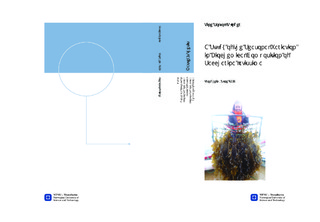| dc.description.abstract | Increasing concerns for climatic changes and increasing fuel cost have encouraged a movement towards alternative fuels, and the global interest and demand for biofuel is increasing. Commercially available biofuels today are derived from terrestrial crops, and continued use of these crops drive the food versus fuel debate. There is a need for an alternative biomass which is sustainable and which do not compete with the production of food and feed, and that does not require the use of pesticides, fertilizers, farmable land and freshwater. Marine biomass such as the macroalgae Saccharina latissima could meet these demands. The present study aimed to examine if there were any differences in the seasonal variation in biochemical composition of S.latissima between 1st and 2nd+ year algae grown at different depths. Two field experiments were conducted from April/March to September/August in 2012 and 201,3 respectively, where two algal age groups (1st and 2nd+) were cultivated at 3m and 8m depths at a semi-sheltered location off the west coast of central Norway. Biomass measurements and samples were collected through the summer and analyzed for carbon, nitrogen, laminaran and mannitol content. Age of the plants was found to have no significant (P > 0.05) impact on the carbohydrate composition in S.latissima. With regards to cultivation depth, the results revealed a depth dependent pattern with higher carbohydrate content at 3m than at 8m depth. The carbohydrate content peaked in June and decreased towards the autumn, while the total carbon content stayed relatively constant throughout the summer, with no significant (P > 0.05) difference between the two depths or age groups. The nitrogen content increased steadily during the summer at both depths and in both age groups. Fouling by bryozoans became a problem from June onwards, with losses of biomass as a direct result. The bryozoans seemed to be the reason for the decrease in mannitol and laminaran towards the autumn, and were likely causing increased nitrogen content throughout the summer. The relatively constant carbon content throughout the summer, despite the decrease in carbohydrates, was likely caused by the chitin and carbonate content of the bryozoan exoskeleton. | nb_NO |
